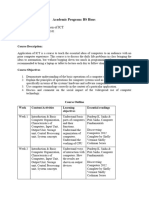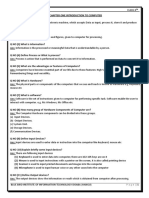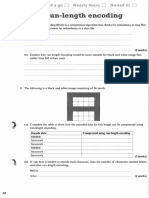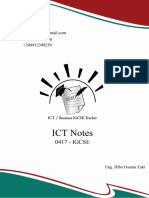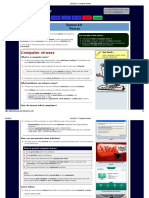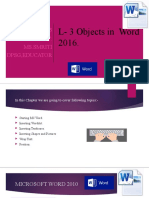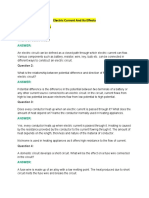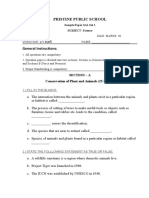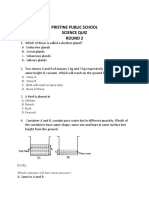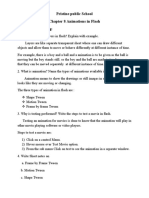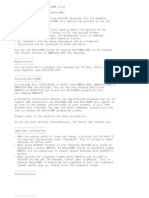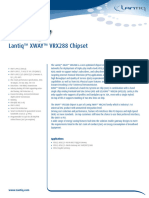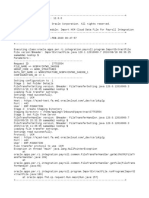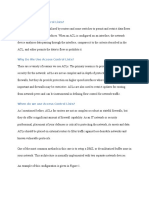Grade 7 Computer Notes
Uploaded by
Kunal SumukGrade 7 Computer Notes
Uploaded by
Kunal SumukPRISTINE PUBLIC SCHOOL
Computer science notes
Chapter –1
Computer software and languages GRADE:7
I. Expand the following abbreviations
1.LLL – Low Level Languages
2.FORTRAN –Formula Translation Computer Programming Languages
3.COBOL – Common Business Oriented Language
4.CAD -- Computer Aided Design
5.BASIC – Beginners All Purpose Symbolic Instruction Code
6.DBMS – Database Management System
II.Write two examples for each of the following
1. Language Processors -- FORTRAN ,COBAOL
2. HLL _ C++, JAVA
3. Utility programs _ Antivirus Software , File manager
4. Operating system _ LINUX , WINDOWS
5. DTP software – Microsoft publisher , Adobe Photoshop
6. Spreadsheet software _ Google sheet , Libre office
III. Answer the following:
1. What is the function of operating system?
An operating system is the software that controls and organizes the working of
the computer. The Common functions of Operating system are given below
Memory
Input/output Management Resource
Management Management
OPERATING SYSTEM
File management
Security
Command Management
Management
2. What is the general purpose software? Give examples
General purpose software is software that are designed to fulfil the general needs of
people. It can be used for commercial and non commercial purposes. Examples of
general purpose software are word processing software, presentation software,
spreadsheet software.
3. Write a short notes on system software and its various types?
A Software that controls the overall internal operations of a computer system is
known as system software.
The system software is further classified into
1. Operating system
2. Device drivers
3. Utility programs
4. Language processors and translators.
4. Differentiate between interpreter and compiler.
Interpreter
Interpreter Compiler
It read the program line by line It read the program line by line.
It translates only one line of the It translates the whole program at a tie
program at a time into machine code into machine code.
It takes less amount of time to analyze It takes large amount of time to analyse
the source code. The source code.
It is slower and requires less memory It is faster and requires more memory
space. space
It is good for beginners It is good for professionals.
Programming language like Python, Programming language like C , C++
Ruby use interpreter use compiler.
5. Describe briefly the generation of computer languages?
First generations of languages Low level languages that are machine
(1940-1956) language
Second generations of languages Used low level assembly languages.that
(1956-1963) is Mnemonic codes or symbols.
Third generations of languages High level language ,that features simple
(1964-1971) and user friendly language ,which lead to
learn and use different computer
languages such as C ,C++, Java.
Fourth generations of computers(1971- very high level languages that consists of
Till Present) statement similar to human language
which features highly user friendly and
independent of any operating system and
designed to reduce the level
ofprogramming efforts.
ex. Python ,SQL
Fifth generations of computers These are programming languages that
have visual tools to develop a program
for the field of artificial intelligence
ex.mercury,OPS5 and prolong.
You might also like
- Computer Revision Worksheet Class 7 Chapter 6100% (6)Computer Revision Worksheet Class 7 Chapter 63 pages
- WB Chapter 6 Automated and Emerging Technologies100% (1)WB Chapter 6 Automated and Emerging Technologies12 pages
- Structure of Matter Question and AnswersNo ratings yetStructure of Matter Question and Answers6 pages
- Module 5: NSX-T Data Center Logical Switching Design: © 2020 Vmware, IncNo ratings yetModule 5: NSX-T Data Center Logical Switching Design: © 2020 Vmware, Inc36 pages
- Ict 1st Comprehensive Worksheet Class 7 Ans KeyNo ratings yetIct 1st Comprehensive Worksheet Class 7 Ans Key7 pages
- gr-7 t2 Computer Practical SQP Ay2022-23No ratings yetgr-7 t2 Computer Practical SQP Ay2022-232 pages
- Class VII-ICT Network & Communication-WK 2No ratings yetClass VII-ICT Network & Communication-WK 23 pages
- CBSE Class 9 Computer Science WorksheetNo ratings yetCBSE Class 9 Computer Science Worksheet1 page
- CBSE Class 8 Computer Science Sample Paper 2017 PDFNo ratings yetCBSE Class 8 Computer Science Sample Paper 2017 PDF1 page
- GCSE Computing Run Length Encoding (RLE) QuestionsNo ratings yetGCSE Computing Run Length Encoding (RLE) Questions1 page
- Revision Practice Worksheet: Grade: IV Subject: Computer 4: More Features of Word100% (2)Revision Practice Worksheet: Grade: IV Subject: Computer 4: More Features of Word3 pages
- Xi Ip Split-Up 2024-25 KVS Ro Guwahati Final-1No ratings yetXi Ip Split-Up 2024-25 KVS Ro Guwahati Final-14 pages
- Assignment 2-2.1.2 Pseudocode and Flowcharts100% (1)Assignment 2-2.1.2 Pseudocode and Flowcharts3 pages
- Chapter 16-17-19 - ICT 0417 Graphs & Charts /document Production/Presentations50% (2)Chapter 16-17-19 - ICT 0417 Graphs & Charts /document Production/Presentations7 pages
- WS - AS - CBSE - VI - Computer Studies - Introduction To OpenOffice CalcNo ratings yetWS - AS - CBSE - VI - Computer Studies - Introduction To OpenOffice Calc3 pages
- Class: 6 Worksheet - Chapter 10 I. Fill in The Blanks33% (3)Class: 6 Worksheet - Chapter 10 I. Fill in The Blanks2 pages
- ICT NOTES - Chapter 7 - The System Life Cycle100% (2)ICT NOTES - Chapter 7 - The System Life Cycle35 pages
- Practical Model Paper Computer Science HSSC-PracticalNo ratings yetPractical Model Paper Computer Science HSSC-Practical2 pages
- Electronic Spreadsheet Notes - Class 9-1 - 240116 - 224244No ratings yetElectronic Spreadsheet Notes - Class 9-1 - 240116 - 2242447 pages
- WSGR3-Unit45-Using, Editingand FormattingInWord2016No ratings yetWSGR3-Unit45-Using, Editingand FormattingInWord20165 pages
- GRADE 6-Subject Computer-Skillsheet No.1-Topic-Working With Tables100% (1)GRADE 6-Subject Computer-Skillsheet No.1-Topic-Working With Tables2 pages
- 1.5 IGCSE ICT Impact of Emerging Technologies Topic Question Paper 1 Set 1 WMNo ratings yet1.5 IGCSE ICT Impact of Emerging Technologies Topic Question Paper 1 Set 1 WM5 pages
- Biology NCERT Control And Coordination QandAnsNo ratings yetBiology NCERT Control And Coordination QandAns4 pages
- Kunal Sumuk M's Presentation (Women and Caste Reforms)100% (1)Kunal Sumuk M's Presentation (Women and Caste Reforms)13 pages
- 2024-25 1st Science Review Test (Reflection, Chem RXN + Nutrition, Respiration)No ratings yet2024-25 1st Science Review Test (Reflection, Chem RXN + Nutrition, Respiration)3 pages
- PHYSICAL AND CHEMICAL CHANGES Question and Answer100% (1)PHYSICAL AND CHEMICAL CHANGES Question and Answer6 pages
- Pristine Public School Worksheet For Class 6: Factors and MultiplesNo ratings yetPristine Public School Worksheet For Class 6: Factors and Multiples2 pages
- Transportation of Materials in Plants and Animals Question and AnswersNo ratings yetTransportation of Materials in Plants and Animals Question and Answers5 pages
- SCIENCE QUIZ 6,7,8 2nd Round Final DraftNo ratings yetSCIENCE QUIZ 6,7,8 2nd Round Final Draft7 pages
- Lantiq™ XWAY™ VRX288 Chipset: True Universal DSL Gateway Solution For Triple-Play Applications/Gigabit EthernetNo ratings yetLantiq™ XWAY™ VRX288 Chipset: True Universal DSL Gateway Solution For Triple-Play Applications/Gigabit Ethernet2 pages
- Question Paper For JTO Phase-I Data Communication: Fill in The Blanks/ Short Answer questions/True/False TypeNo ratings yetQuestion Paper For JTO Phase-I Data Communication: Fill in The Blanks/ Short Answer questions/True/False Type3 pages
- GFI Backup 2011 Administration and Configuration ManualNo ratings yetGFI Backup 2011 Administration and Configuration Manual168 pages
- DMVPN (Dynamic Multipoint VPN) : A Solution For Interconnection of Sites IPv6 Over An IPv4 Transport NetworkNo ratings yetDMVPN (Dynamic Multipoint VPN) : A Solution For Interconnection of Sites IPv6 Over An IPv4 Transport Network6 pages
- Apricot 2017 - Segment Routing Tutorial v1.0 - 1488180101No ratings yetApricot 2017 - Segment Routing Tutorial v1.0 - 148818010184 pages





